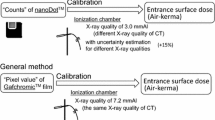Abstract
Recently, there has been a significant amount of interest in studying the importance of radiation doses to the eye lens during endoscopic retrograde cholangiopancreatography (ERCP). A study that focused on measuring the scattered radiation using an ionization chamber survey meter reported that a lead curtain was useful in reducing the scattered radiation. The over-couch X-ray tube system tends to deliver higher doses to the head and neck of the staff involved in the procedure than the under-couch X-ray tube position. In this study, a small optically stimulated luminescence (OSL) dosimeter called the nanoDot was used to evaluate and measure the amount of radiation; this dosimeter was developed by Landauer Ltd. and was specifically designed for point measurements. There are numerous studies that have reported the usefulness of personal OSL dosimeters other than the nanoDot to measure scattered radiation. Here, we evaluated the amount of scattered radiation, along with the degree of reduction achieved with the use of a protective curtain, while employing a personal OSL dosimeter and nanoDot. When the scattered radiation dose was measured using the nanoDot, the maximum recorded value without a protective curtain was 0.363 mGy and that with a protective curtain was 0.026 mGy, both at the height of 100 cm. The maximum reduction rate of scattered radiation while using a protective curtain was approximately 93% and 97% at 100 cm and 150 cm, respectively. The measured values recorded using both personal OSL dosimeters and nanoDot machine were strongly correlated.






Similar content being viewed by others
References
Stewart FA, Akleyev AV, Hauer-Jensen M, Hendry JH, Kleiman NJ, Macvittie TJ, Aleman BM, Edgar AB, Mabuchi K, Muirhead CR, Shore RE, Wallace WH. ICRP publication 118: ICRP statement on tissue reactions and early and late effects of radiation in normal tissues and organs–threshold doses for tissue reactions in a radiation protection context. Ann ICRP. 2012;41(1–2):1–322.
Matsubara K, Koshida K, Noto K, Takata T, Suzuki M, Shimono T, Yamamoto T, Matsui O. A head phantom study for intraocular dose evaluation of 64-slice multidetector CT examination in patients with suspected cranial trauma. Eur J Radiol. 2011;79(2):283–7.
Take T, Sato K, Kiuchi K, Nakazawa Y. Creation of a crystalline lens radiation exposure defense cover and the effect of radiation exposure decrease on neuro-interventions. Jpns Soc Radiol Technol. 2007;63:1246–52.
O’Connor U, Gallagher A, Malone L, O’Reilly G. Occupational radiation dose to eyes from endoscopic retrograde cholangiopancreatography procedures in light of the revised eye lens dose limit from the International Commission on Radiological Protection. Br J Radiol. 2013;86:20120289.
Yoshida R, et al. Evaluation of usefulness of X-ray tube protector for X-ray fluoroscopy in ERCP etc. J Jpn Assoc Rural Med. 2014;63–2:127–31.
Jursinic PA. Characterization of optically stimulated luminescent dosimeters, OSLs, for clinical dosimetric measurements. Med Phys. 2007;34:4594–604.
Kerns JR, Kry SF, Sahoo N, Followill DS, Ibbott GS. Angular dependence of the nanoDot OSL dosimeter. Med Phys. 2011;38:3955–62.
Hayashi H, et al. High accuracy measurements by consecutive readings of OSL dosimeter. Med Imaging Inf Sci. 2014;31:228–34.
Landauer, Inc. microStar User Manual, 1–66. Glenwood: Landauer Inc.; 2009.
Chida K. Evaluation and protection of surgeon exposure in interventional radiology. Jpn Soc Radiol Technol. 2008;50:1009–144.
Kusama T. Anata to Kanja notameno Housyasenbougo Q&A Radiation protection for you and the patient Q&A. Iryo kagakusya. 1996;1:98–9.
Tomita H, Morozumi K. Measurement of scatter radiation on MDCT equipment using an OSL dosimeter. Jpn Soc Radiol Technol. 2004;60:1550–4.
Author information
Authors and Affiliations
Corresponding author
Ethics declarations
Conflict of interest
Ikuo Kobayashi is an employee of Nagase Landauer Ltd., Japan. All authors, except Ikuo Kobayashi, declare no conflict of interest. The device (nanodot, microStar) used in this study was provided by Nagase Landauer Ltd., Japan.
Human rights
All procedures performed in studies involving human participants were in accordance with the ethical standards of the Institutional Review Board (IRB) and with the 1964 Helsinki declaration and its later amendments or comparable ethical standards.
Informed consent
This article does not contain any studies with human participants performed.
Animal rights
This article does not contain any studies with animals performed.
Additional information
Publisher's Note
Springer Nature remains neutral with regard to jurisdictional claims in published maps and institutional affiliations.
About this article
Cite this article
Ito, H., Kobayashi, I., Watanabe, K. et al. Evaluation of scattered radiation from fluoroscopy using small OSL dosimeters. Radiol Phys Technol 12, 393–400 (2019). https://doi.org/10.1007/s12194-019-00536-4
Received:
Revised:
Accepted:
Published:
Issue Date:
DOI: https://doi.org/10.1007/s12194-019-00536-4




